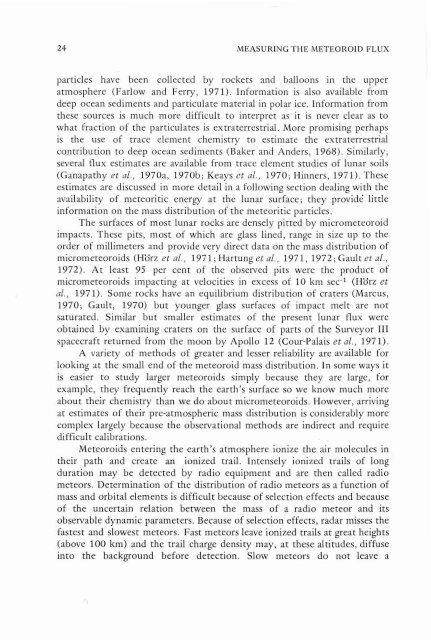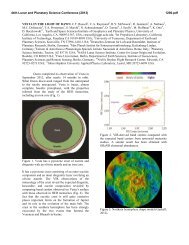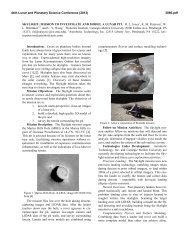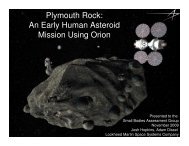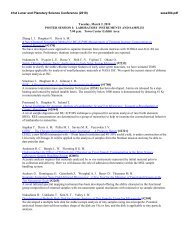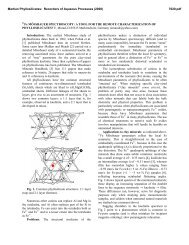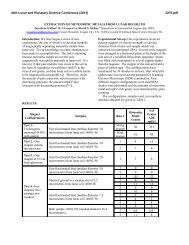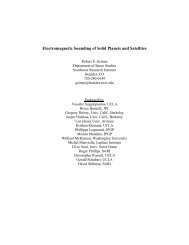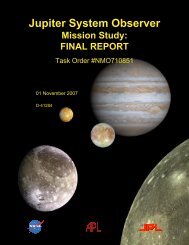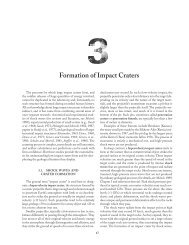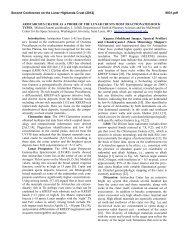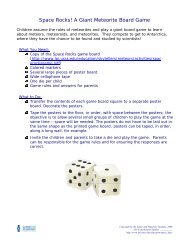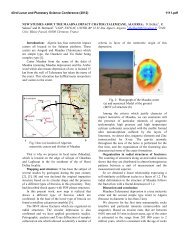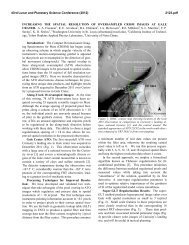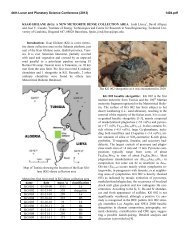Chapter 2: Energy at the Lunar Surface - Lunar and Planetary Institute
Chapter 2: Energy at the Lunar Surface - Lunar and Planetary Institute
Chapter 2: Energy at the Lunar Surface - Lunar and Planetary Institute
Create successful ePaper yourself
Turn your PDF publications into a flip-book with our unique Google optimized e-Paper software.
24 MEASURING THE METEOROID FLUX<br />
particles have been collected by rockets <strong>and</strong> balloons in <strong>the</strong> upper<br />
<strong>at</strong>mosphere (Farlow <strong>and</strong> Ferry, 1971). Inform<strong>at</strong>ion is also available from<br />
deep ocean sediments <strong>and</strong> particul<strong>at</strong>e m<strong>at</strong>erial in polar ice. Inform<strong>at</strong>ion from<br />
<strong>the</strong>se sources is much more difficult to interpret as it is never clear as to<br />
wh<strong>at</strong> fraction of <strong>the</strong> particul<strong>at</strong>es is extr<strong>at</strong>errestrial. More promising perhaps<br />
is <strong>the</strong> use of trace element chemistry to estim<strong>at</strong>e <strong>the</strong> extr<strong>at</strong>errestrial<br />
contribution to deep ocean sediments (Baker <strong>and</strong> Anders, 1968). Similarly,<br />
several flux estim<strong>at</strong>es are available from trace element studies of lunar soils<br />
(Ganap<strong>at</strong>hy et al., 1970a, 1970b; Keays et al., 1970; Hinners, 1971). These<br />
estim<strong>at</strong>es are discussed in more detail in a following section dealing with <strong>the</strong><br />
availability of meteoritic energy <strong>at</strong> <strong>the</strong> lunar surface; <strong>the</strong>y providi little<br />
inform<strong>at</strong>ion on <strong>the</strong> mass distribution of <strong>the</strong> meteoritic particles.<br />
The surfaces of most lunar rocks are densely pitted by micrometeoroid<br />
impacts. These pits, most of which are glass lined, range in size up to <strong>the</strong><br />
order of millimeters <strong>and</strong> provide very direct d<strong>at</strong>a on <strong>the</strong> mass distribution of<br />
micrometeoroids (Hb'rz et al., 197 1 ; Hartung et al., 197 1, 1972 ; Gault et al.,<br />
1972). At least 95 per cent of <strong>the</strong> observed pits were <strong>the</strong> product of<br />
micrometeoroids impacting <strong>at</strong> velocities in excess of 10 km sec-1 (Hb'rz et<br />
al., 197 1). Some rocks have an equilibrium distribution of cr<strong>at</strong>ers (Marcus,<br />
1970; Gault, 1970) but younger glass surfaces of impact melt are not<br />
s<strong>at</strong>ur<strong>at</strong>ed. Similar but smaller estim<strong>at</strong>es of <strong>the</strong> present lunar flux were<br />
obtained by examining cr<strong>at</strong>ers on <strong>the</strong> surface of parts of <strong>the</strong> Surveyor 111<br />
spacecraft returned from <strong>the</strong> moon by Apollo 12 (Cour-Palais et al., 197 1).<br />
A variety of methods af gre<strong>at</strong>er <strong>and</strong> lesser reliability are available for<br />
looking <strong>at</strong> <strong>the</strong> small end of <strong>the</strong> meteoroid mass distribution. In some ways it<br />
is easier to study larger meteoroids simply because <strong>the</strong>y are large, for<br />
example, <strong>the</strong>y frequently reach <strong>the</strong> earth's surface so we know much more<br />
about <strong>the</strong>ir chemistry than we do about micrometeoroids. However, arriving<br />
<strong>at</strong> estim<strong>at</strong>es of <strong>the</strong>ir pre-<strong>at</strong>mospheric mass distribution is considerably more<br />
complex largely because <strong>the</strong> observ<strong>at</strong>ional methods are indirect <strong>and</strong> require<br />
difficult calibr<strong>at</strong>ions.<br />
Meteoroids entering <strong>the</strong> earth's <strong>at</strong>mosphere ionize <strong>the</strong> air molecules in<br />
<strong>the</strong>ir p<strong>at</strong>h <strong>and</strong> cre<strong>at</strong>e an ionized trail. Intensely ionized trails of long<br />
dur<strong>at</strong>ion may be detected by radio equipment <strong>and</strong> are <strong>the</strong>n called radio<br />
meteors. Determin<strong>at</strong>ion of <strong>the</strong> distribution of radio meteors as a function of<br />
mass <strong>and</strong> orbital elements is difficult because of selection effects <strong>and</strong> because<br />
of <strong>the</strong> uncertain rel<strong>at</strong>ion between <strong>the</strong> mass of a radio meteor <strong>and</strong> its<br />
observable dynamic parameters. Because of selection effects, radar misses <strong>the</strong><br />
fastest <strong>and</strong> slowest meteors. Fast meteors leave ionized trails <strong>at</strong> gre<strong>at</strong> heights<br />
(above 100 km) <strong>and</strong> <strong>the</strong> trail charge density may, <strong>at</strong> <strong>the</strong>se altitudes, diffuse<br />
into <strong>the</strong> background before detection. Slow meteors do not leave a


